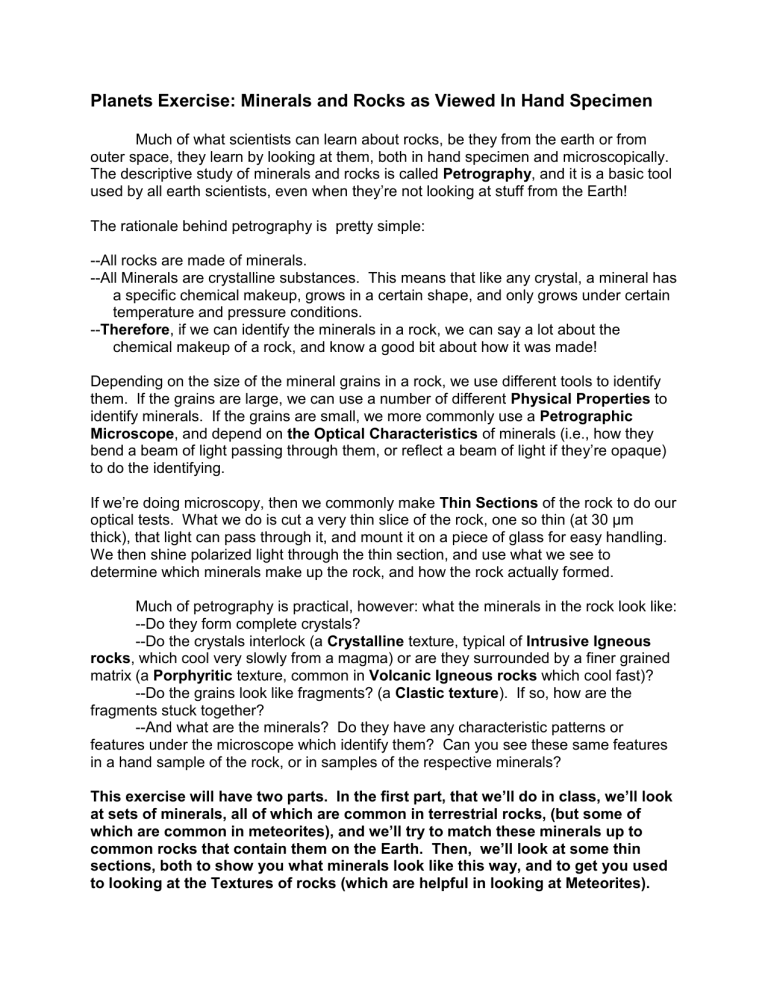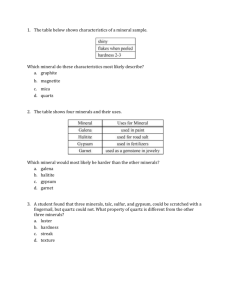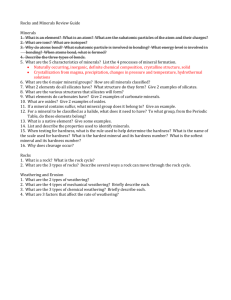Rocks and Minerals in Hand Sample

Planets Exercise: Minerals and Rocks as Viewed In Hand Specimen
Much of what scientists can learn about rocks, be they from the earth or from outer space, they learn by looking at them, both in hand specimen and microscopically.
The descriptive study of minerals and rocks is called Petrography , and it is a basic tool used by all earth scientists, even when they’re not looking at stuff from the Earth!
The rationale behind petrography is pretty simple:
--All rocks are made of minerals.
--All Minerals are crystalline substances. This means that like any crystal, a mineral has a specific chemical makeup, grows in a certain shape, and only grows under certain temperature and pressure conditions.
-Therefore , if we can identify the minerals in a rock, we can say a lot about the chemical makeup of a rock, and know a good bit about how it was made!
Depending on the size of the mineral grains in a rock, we use different tools to identify them. If the grains are large, we can use a number of different Physical Properties to identify minerals. If the grains are small, we more commonly use a Petrographic
Microscope , and depend on the Optical Characteristics of minerals (i.e., how they bend a beam of light passing through them, or reflect a beam of light if the y’re opaque) to do the identifying.
If we’re doing microscopy, then we commonly make
Thin Sections of the rock to do our optical tests. What we do is cut a very thin slice of the rock, one so thin (at 30 µm thick), that light can pass through it, and mount it on a piece of glass for easy handling.
We then shine polarized light through the thin section, and use what we see to determine which minerals make up the rock, and how the rock actually formed.
Much of petrography is practical, however: what the minerals in the rock look like:
--Do they form complete crystals?
--Do the crystals interlock (a Crystalline texture, typical of Intrusive Igneous rocks , which cool very slowly from a magma) or are they surrounded by a finer grained matrix (a Porphyritic texture, common in Volcanic Igneous rocks which cool fast)?
--Do the grains look like fragments? (a Clastic texture ). If so, how are the fragments stuck together?
--And what are the minerals? Do they have any characteristic patterns or features under the microscope which identify them? Can you see these same features in a hand sample of the rock, or in samples of the respective minerals?
This exercise will have two parts. In the first part, that we’ll do in class, we’ll look at sets of minerals, all of which are common in terrestrial rocks, (but some of which are common in meteorites), and we’ll try to match these minerals up to common rocks that contain them on the Earth. Then, we’ll look at some thin sections, both to show you what minerals look like this way, and to get you used to looking at the Textures of rocks (which are helpful in looking at Meteorites).
1) In each tray are the following mineral samples :
Quartz,
Mica,
Talc,
Calcite and
Hematite (common on the Earth);
Olivine,
Pyroxene and
Plagioclase (common in both terrestrial and extraterrestrial rocks); and
Pyrite and
Sphalerite (metal sulfide minerals, like some found in meteorites).
For each of these minerals, I want you to list its set of distinctive physical properties
[The Back Page of this Exercise contains a list of these properties, and we’ll discuss them in class]. Of the properties you discover these minerals have, circle the one characteristic (if there is any) that is a "dead giveaway" property, i.e., if you were to pick up a piece of this mineral somewhere else, which property would tell you right away what it was. Set your work up in checklist fashion, so that it will be easy for you (and me) to read and refer to:
Hardness
Mineral A >2 1/2
Mineral B >3; <5 1/2
Cleavage yes/1 direction conc. fracture
Color blue orange
Luster.... metallic ..... glassy....
NOTE: JUST DO THE MINERAL SAMPLES LISTED ABOVE FOR QUESTION 1!! If you do the rocks as well (see below), it will just confuse you!!
Now, let's turn the exercise on its head. Rocks are simply amalgamations of minerals, which form in a variety of ways . Igneous Rocks crystallize from molten materials, or magmas; Sedimentary Rocks form by Lithification of materials deposited in sedimentary basins, and Metamorphic Rocks form when either of these 3 rock types are changed by a change in confining pressure or temperature.
Take notes on answers to these in class, and send me your responses by email!!
2a) In each tray, there should be a Granite , which is a common igneous rock all over the Earth. Granites form from silica-rich magmas which cool slowly very deep in the
Earth.
--You have seen every mineral in this granite already today. Use what you know about the minerals above to identify which ones might be in the Granite.
2b) This tray contains Sandstone , a common Sedimentary Rock . Use the properties of the minerals that you listed (and a little common sense) to determine the minerals that make up this rock.
One key thing we do with sedimentary rocks on Earth is try and understand their ancient Depositional Environments , i.e., where the sediments piled up and why, using the principles of Uniformitarianism , which, simply stated, is that processes which happened on the Earth in the distant past can be inferred from what we see happening today.
--Where on the Earth might you make a rock that looks like a Sandstone?
--Can you imagine how to make a rock like this in outer Space? What would have to happen for it to be possible?
2c) Gneiss is a Metamorphic rock which often forms when Granites are heated and compressed. Compare the Textures of each rock (i.e., the size and shape of the mineral grains) and their Fabric (i.e., how the mineral grains are arranged.
--How are Gneiss and Granite similar? How are they different?
Now, for a terrestrial rock more like rocks from outer space:
3a) Gabbro: Gabbros contain the same basic minerals that most Lunar rocks and stony meteorites contain. Gabbros are, however, Igneous Rocks , that crystallize deep in the
Earth from the same kinds of magmas that erupt today in Hawaii. Gabbros bear some textural similarities to Granites, due to the fact that both of them crystallize slowly at depth.
-Try and figure out which of the minerals you’ve seen today are in these
Gabbro samples. Believe it or not, you’ve seen all the minerals that are in it!
[Hint: look at the color shades of the different grains!]
--Note the interlocking crystal texture of this Gabbro, similar on a finer scale to that in the Granite. If Lunar rocks were to have this kind of texture, can you make a first-cut guess as to how they may have formed?
Mineral Properties:
Hardness: How resistant a mineral is to being scratched. Probably the easiest property to evaluate, and the most useful. We in geology use what is called the Mohs
Hardness Scale , a ten step scale of increasing hardness, calibrated by specific, common minerals:
1) (softest) Talc
2) Gypsum
3) Calcite
4) Fluorite
5) Apatite
6) Feldspar
7) Quartz
8) Topaz
9) Corundum
10) (hardest) Diamond
Much of the time, however, geologists are without handy bits of all of these Mohs minerals, so we make do with what we can find:
Fingernail: Mohs hardness: 2 1/2
U.S. Penny: hardness: 3
Common Steel Pocketknife: 5 1/2
Glass: 5 1/2
And, since it's the hardest common mineral, and there always seems to be some around, I typically shove a piece of quartz (7) in my pocket to round out my hardness field kit.
Color/Luster: The first thing evident about a mineral, and potentially the least useful feature for identifying them. For some minerals, color is diagnostic (Turquoise is always blue, for example), but most minerals can occur in a variety of colors.
A more useful feature of the mineral's appearance is its Luster, or the way that it shines in the light. Luster is a diagnostic (or dead giveaway) property for identifying many minerals.
Types of Lusters:
Glassy, or Vitreous (quartz, fluorite, apatite, halite, gypsum, corundum, calcite)
Metallic (covellite, graphite, pyrite, galena)
Resinous, or Greasy
Earthy
(Sphalerite, talc)
[or no luster] (Hematite)
Adamantine (ultra-vitreous: very bright) [ rutile, chromite]
Cleavage: When a mineral breaks along flat, planar surfaces. Most minerals possess cleavage of some sort, in some direction. Many others possess cleavages in several directions. Both the number and direction of cleavage planes in a mineral are important, though often enough, in the field, we just note the presence of promiment cleavage.
Some minerals don't break along cleavage planes at all: these are said to
Fracture . Quartz is the most prominent mineral lacking cleavage, and has what is
called Conchoidal Fracture -- which is to say that it breaks off in curved slivers, just like glass.
Streak: Streak is the color that rubs off the mineral when it is scraped against a streak plate: a square of unglazed porcelain. The hardness of a streak plate is typically around 5 1/2, so streak is mostly useful for softer minerals, especially the darker, metalbearing minerals.
Other Useful properties for identifying minerals:
Density: The amount of mass per unit volume of a mineral, measured in grams/cubic centimeter (g/cc). Density is just as distinctive and diagnostic as hardness, but it is much trickier to measure in the field or classroom.
In the field we can make some convenient assumptions regarding density: most of the common minerals we encounter (quartz, feldspar, calcite, fluorite, apatite, mica) have about the same, relatively low density: 2.5-3 g/cc, so if you pick up pieces of them, they "heft" about the same. Minerals with metals in their composition, like iron or zinc or copper or lead, are commonly much denser (> 3.5 g/cc) and thus they "heft" distinctly heavier. So one can use density qualitatively: the sample is "denser than quartz" or "about as dense as quartz", which allows you to place some constraints on it.
Feel: Some minerals have a unique feel to them when rubbed: they may be soapy or greasy feeling, or they may rub off on you, or on a sheet of paper.
Magnetism: Certain iron and nickel bearing minerals may be attracted to a hand magnet. Only one mineral, the black iron oxide called Magnetite may actually be magnetic. If it is, we call it Lodestone.
Odor: Clay minerals commonly have an earthy odor to them, and some sulfur-bearing minerals may have a rotten egg smell. Sometimes minerals produce an odor when rubbed against a streak plate, so it's worthwhile giving the streak a sniff.
Taste: If it tastes like anything, you'll know what it is.
Solubility in Hydrochloric Acid: Carbonate minerals will dissolve and fizz in a 10% solution of hydrochloric acid.







